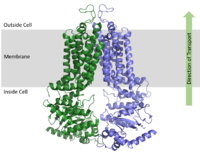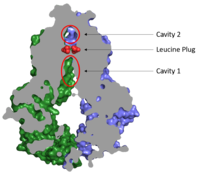Sandbox Reserved 1606
From Proteopedia
(Difference between revisions)
| Line 13: | Line 13: | ||
As an [https://en.wikipedia.org/wiki/ATP-binding_cassette_transporter ABC Transporter], ABCG2 exhibits ATPase activity in which the protein binds and hydrolyzes ATP. After the binding of a substrate, one molecule of <scene name='83/832932/Atp_bound_use/1'>ATP binds each NBD</scene> causing a conformational change of the overall structure from an <scene name='83/832932/Overall_structure/2'>open conformation</scene> with no ATP bound to a <scene name='83/832932/Atp_bound_use/1'>closed conformation</scene>. One molecule of ATP is hydrolyzed to transport substrates across the cell membrane while the second molecule of ATP is hydrolyzed to reset the transporter to its open conformation. | As an [https://en.wikipedia.org/wiki/ATP-binding_cassette_transporter ABC Transporter], ABCG2 exhibits ATPase activity in which the protein binds and hydrolyzes ATP. After the binding of a substrate, one molecule of <scene name='83/832932/Atp_bound_use/1'>ATP binds each NBD</scene> causing a conformational change of the overall structure from an <scene name='83/832932/Overall_structure/2'>open conformation</scene> with no ATP bound to a <scene name='83/832932/Atp_bound_use/1'>closed conformation</scene>. One molecule of ATP is hydrolyzed to transport substrates across the cell membrane while the second molecule of ATP is hydrolyzed to reset the transporter to its open conformation. | ||
| - | When ATP binds, the conformational change is the result of various helices in the NBD and TMD rotating in order to promote transport. | + | When ATP binds, the conformational change is the result of various helices in the NBD and TMD rotating in order to promote transport of substrates. |
Revision as of 20:51, 4 April 2020
| This Sandbox is Reserved from Jan 13 through September 1, 2020 for use in the course CH462 Biochemistry II taught by R. Jeremy Johnson at the Butler University, Indianapolis, USA. This reservation includes Sandbox Reserved 1598 through Sandbox Reserved 1627. |
To get started:
More help: Help:Editing |
ABCG2 Multidrug Transporter
| |||||||||||
References
- ↑ 1.0 1.1 1.2 1.3 Taylor NMI, Manolaridis I, Jackson SM, Kowal J, Stahlberg H, Locher KP. Structure of the human multidrug transporter ABCG2. Nature. 2017 Jun 22;546(7659):504-509. doi: 10.1038/nature22345. Epub 2017 May, 29. PMID:28554189 doi:http://dx.doi.org/10.1038/nature22345
- ↑ 2.0 2.1 Manolaridis I, Jackson SM, Taylor NMI, Kowal J, Stahlberg H, Locher KP. Cryo-EM structures of a human ABCG2 mutant trapped in ATP-bound and substrate-bound states. Nature. 2018 Nov;563(7731):426-430. doi: 10.1038/s41586-018-0680-3. Epub 2018 Nov, 7. PMID:30405239 doi:http://dx.doi.org/10.1038/s41586-018-0680-3
Student Contributors
Julia Pomeroy


